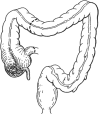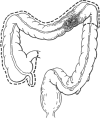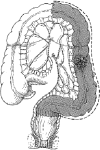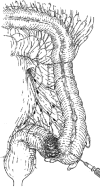Preoperative evaluation and oncologic principles of colon cancer surgery
- PMID: 20011299
- PMCID: PMC2780098
- DOI: 10.1055/s-2005-916277
Preoperative evaluation and oncologic principles of colon cancer surgery
Abstract
Colorectal cancer is the third most common malignancy in men and women and accounts for 10% of all cancer deaths. The primary risk factor for colorectal cancer is advancing age, but other factors also play a role in its development, including genetic predisposition, smoking, alcohol consumption, obesity, and high-fat, low-fiber diet. Colon cancer survival is primarily related to the stage of disease at diagnosis. The main screening tests for colon cancer are fecal occult blood testing, flexible sigmoidoscopy, double-contrast barium enema, and colonoscopy. The pre-operative evaluation should include a complete blood count, carcinoembryonic antigen (CEA), colonoscopy, and chest radiograph. Other preoperative evaluations are patient specific or of unproven benefit. The operative procedure should include a bowel preparation, parenteral antibiotics, and deep venous thrombosis prophylaxis. The procedure performed must be tailored to the location of the colon cancer but should include complete, en bloc resection of the cancer and its lymphatic drainage, including locally invaded structures. The bowel margins of resection should be at least 5 cm from the tumor to minimize anastomotic recurrences. Laparoscopic colectomy has been shown to be as safe and effective as open colectomy for the treatment of colon cancer. The use of sentinel lymph node biopsy is feasible but has not yet been proved clinically useful. Surveillance after surgery for colon cancer is necessary to monitor for metastatic disease or local recurrence. Several groups have made surveillance recommendations including office visits, colonoscopy, and CEA monitoring.
Keywords: Colon cancer; colectomy; screening.
Figures




Similar articles
-
Minimally invasive surgery for colorectal cancer. Initial follow-up.Ann Surg. 1996 Jun;223(6):790-6; discussion 796-8. doi: 10.1097/00000658-199606000-00017. Ann Surg. 1996. PMID: 8645052 Free PMC article.
-
An evaluation of postoperative follow-up tests in colon cancer patients treated for cure.Oncology. 1997 Jul-Aug;54(4):287-92. doi: 10.1159/000227705. Oncology. 1997. PMID: 9216852
-
Sodium picosulfate/magnesium citrate: a review of its use as a colorectal cleanser.Drugs. 2009;69(1):123-36. doi: 10.2165/00003495-200969010-00009. Drugs. 2009. PMID: 19192941 Review.
-
Laparoscopic resection of transverse colon cancer: long-term oncologic outcomes in 58 patients.J Laparoendosc Adv Surg Tech A. 2012 Jul-Aug;22(6):561-6. doi: 10.1089/lap.2011.0422. Epub 2012 Jun 12. J Laparoendosc Adv Surg Tech A. 2012. PMID: 22690652
-
Virtual colonoscopy in colorectal cancer screening.Surg Innov. 2007 Mar;14(1):27-34. doi: 10.1177/1553350607299563. Surg Innov. 2007. PMID: 17442877 Review.
Cited by
-
Molecular and Immunohistochemical Markers with Prognostic and Predictive Significance in Liver Metastases from Colorectal Carcinoma.Int J Mol Sci. 2018 Oct 3;19(10):3014. doi: 10.3390/ijms19103014. Int J Mol Sci. 2018. PMID: 30282914 Free PMC article. Review.
-
Raman Spectroscopy: A Personalized Decision-Making Tool on Clinicians' Hands for In Situ Cancer Diagnosis and Surgery Guidance.Cancers (Basel). 2022 Feb 23;14(5):1144. doi: 10.3390/cancers14051144. Cancers (Basel). 2022. PMID: 35267451 Free PMC article. Review.
-
The Specific Gravity-Free Method for the Isolation of Circulating Tumor KRAS Mutant DNA and Exosome in Colorectal Cancer.Micromachines (Basel). 2021 Aug 20;12(8):987. doi: 10.3390/mi12080987. Micromachines (Basel). 2021. PMID: 34442609 Free PMC article.
-
Treatment response prediction of neoadjuvant chemotherapy for rectal cancer by deep learning of colonoscopy images.Oncol Lett. 2023 Sep 20;26(5):474. doi: 10.3892/ol.2023.14062. eCollection 2023 Nov. Oncol Lett. 2023. PMID: 37809043 Free PMC article.
-
Transanal endoscopic video-assisted excision: application of single-port access.JSLS. 2011 Jan-Mar;15(1):53-8. doi: 10.4293/108680810X12924466009005. JSLS. 2011. PMID: 21902943 Free PMC article.
References
-
- American Cancer Society Cancer Facts and Figures 2003. Available at http://www.cancer.org/docroot/STT/stt_0_2003.asp?sitearea=S.... Accessed December 6, 2004. Available at http://www.cancer.org/docroot/STT/stt_0_2003.asp?sitearea=S...
-
- American Cancer Society Cancer Statistics 2004. Available at http://www.cancer.org/docroot/STT/stt_0.asp. Accessed December 7, 2004. Available at http://www.cancer.org/docroot/STT/stt_0.asp
-
- Carstensen B, Soll-Johanning H, Villadsen E, Sondergaard J O, Lynge E. Familial aggregation of colorectal cancer in the general population. Int J Cancer. 1996;68:428–435. - PubMed
-
- Samowitz W S, Curtin K, Lin H H, et al. The colon cancer burden of genetically defined hereditary nonpolyposis colon cancer. Gastroenterology. 2001;121:830–838. - PubMed
-
- Aaltonen L A, Salovaara R, Kristo P, et al. Incidence of hereditary nonpolyposis colorectal cancer and the feasibility of molecular screening for the disease. N Engl J Med. 1998;338:1481–1487. - PubMed
LinkOut - more resources
Full Text Sources
Research Materials

